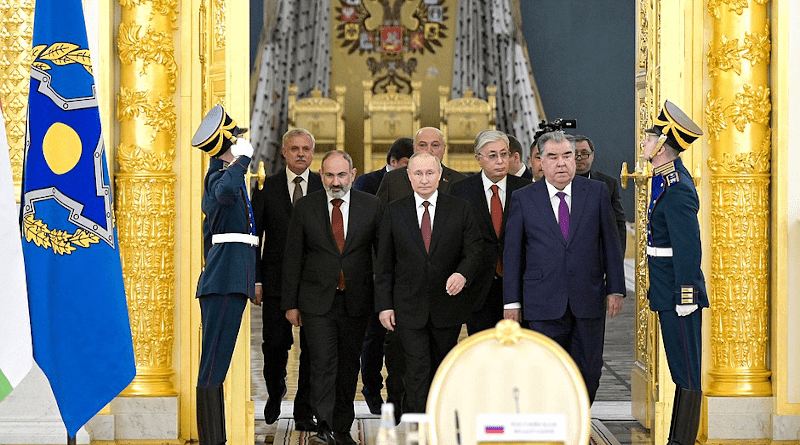Russia’s Dying Eurasian Dream – Analysis
Russian multilateralism is unraveling. Cracks that were always visible within the Kremlin-dominated Collective Security Treaty Organization (CSTO) and Eurasian Economic Union (EEU) groupings are now becoming ever more explicit.
The immediate cause is Russia’s aggression against Ukraine, which has laid bare and further exacerbated the inherent weaknesses and self-interest within its regional initiatives. The geographic scope of these organizations is staggering — from the Caucasus to the Tajik-Kyrgyz border — but the sheer size of the area concerned merely highlights Russia’s dissipated strength and focus.
Since its decisive victory in the 2020 Second Nagorno-Karabakh War, Azerbaijan has resorted to a more coercive strategy toward its neighbor and longtime rival, Armenia. Militarily more powerful, it has sought to impose its rules of the game on the weakened neighbor.
Russia is supposed to be Armenia’s protector, and it has the means to intervene through CSTO, where Armenia is a member and Azerbaijan is not. CSTO’s Article 4 (a vague mirror of NATO’s Article 5), states:
If one of the States Parties is subjected to aggression by any state or group of states, then this will be considered as aggression against all States Parties to this Treaty. In the event of an act of aggression against any of the participating States, all other participating States will provide the necessary assistance, including military aid . . .
Yet, time and again the Kremlin has turned a deaf ear to Armenian demands that CSTO meet its obligations. Russia has argued that Nagorno-Karabakh was not Armenian territory and that therefore the CSTO security obligation did not apply. Even when Azerbaijan bombed Armenian cities deep inside the country and far from Karabakh itself, Russia merely dispatched a fact-finding missionto the South Caucasus.
The message was clear — Russia was not only unwilling, but also unable to come to Armenia’s aid. Understandably, this caused Armenia to question its security fundamentals; if the Kremlin no longer intended to fulfill its obligations, what was the point of its long-time dependence? The official alliance between the two was signed back in the 1990s. At that time, the South Caucasus was a very different place — Russia was a very significant power with its military deployed in and very familiar with the region, while Armenia had conquered Nagorno-Karabakh in the first war for the area in 1988-94.
The underlying thinking in Armenia throughout the decades since has been that CSTO membership and Russia alliance would balance the Azerbaijan-Turkey axis. This turned out to be a serious error. Russia, it transpired, valued relations with Azerbaijan at least as much (if not more) than with Armenia.
CSTO has faced challenges on other fronts. In September, when the members of and candidates to the Chinese-dominated Shanghai Cooperation Organization (SCO) met in Samarkand, Tajikistan launched a cross-border attack on neighboring Kyrgyzstan. Both are members of CSTO and the presidents of both republics were attending the summit. Putin did not react, and nor did CSTO. At this point, Kyrgyzstan pulled out of the organization’s scheduled military exercises and openly complained about its inadequacy.
The underlying cause behind these two geographically disparate developments was the same. Russia’s fortunes have become increasingly grimin what once was the Soviet space, an area that the Kremlin likes to possessively refer to as the near-abroad.
Troubles with Russia’s multilateral projects run still deeper. Another Eurasian integrationist project, the EEU, created in 2015 and plausibly regarded as Vladimir Putin’s baby, is likewise experiencing profound troubles. Flaws within the organization — which includes as members Armenia, Belarus, Kazakhstan, Kyrgyzstan, and Russia — were seeded long before 2022, with Russia being the largest in absolute numbers and mostly dictating the terms to fellow member states. But since the invasion started, disagreements have worsened. EEU members complain they are unprotected and victims of Russia’s economic “egocentrism”. Recent examples include cutting Kazakhstan’s oil export pipeline with barely any notice, pressures on Central Asian migrants inside Russia, who provide important remittances to their home countries, and unilateral demands to lower trade barriers with little reciprocation.
The ripple effects of such behavior are long-lasting. Kazakhstan recently blocked Russian grain export to Central Asia and China. It also set out to develop new transit routes to circumvent Russia through the Caspian Sea and the South Caucasus. The quantities exported are still small, but the trend is obvious: less dependence on Russia economically and geographically. Russian high level officials have lashed out at Kazakhstan, accusing it of deliberately subverting the EEU.
The EEU and CSTO are meanwhile moribund and there are no signs that they will add new members. Unreliability and economic selfishness are hardly major draws for potential joiners.
The decline of Russian multilateral efforts could mark an end to the post-Soviet era in Eurasia. The Kremlin is seeing its influence thinning, its garrisons stripped of men for the war in Ukraine, its trade enmeshed by sanctions, while South Caucasus and Central Asia consider the prospects with rivals. A new period begins where Russia becomes just one of many players along with Turkey, China, and Iran; none are necessarily Russia’s enemies, but each has its own interests to pursue.
This also opens avenues for greater Western involvement in the Caucasus and Central Asia. With less Russian pressure, there is a greater welcome for outside actors. Financial support will be critical, but no less important is the development of infrastructure to bypass Russia.
In that regard, European Union (EU) President Charles Michel’s visit to Kazakhstan is a promising signal, as is Olivér Várhelyi’s recent trip to Georgia.
This article was first published by CEPA

